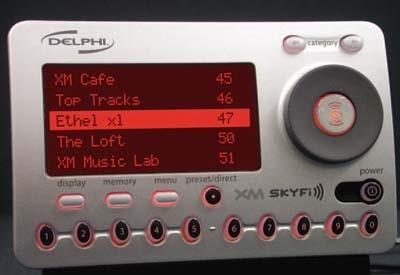Delphi SkyFi XM Satellite Radio Receiver

From their TV ads, it's easy to see that both XM and Sirius satellite radio are aimed first and foremost at the car market. Sirius commercials portray a typical listener as a family man who loves being behind the wheel, while XM's incorporate strangely violent imagery of grand pianos plunging onto highways and shattering into millions of pieces. Sure, drivers can reach for the sky, but stationary listeners have been asking, "What about us?" ever since the satellites took orbit. Until recently, the only answer had been Sony's DRN-XM01 ($300), an XM receiver you can shuttle between your home and your dashboard. Following in its footsteps, the new Delphi SkyFi XM tuner can do the same thing. With the SkyFi tuner ($130) and both the home and car adapter kits ($70 each), you get XM to go for a grand total of $270. Of course, you'll also need a basic XM subscription, which costs $9.99 a month. The SkyFi can even plug into a Delphi portable boombox ($99), but none were available for testing at press time. The SkyFi was a breeze to set up at home. The small (4 3/8 x 2 7/8 x 1 1/4 inches) tuner sits in an equally small cradle, which has connectors for the antenna, line output, and power. I used the supplied interconnect cable to hook into a spare set of analog stereo inputs on my A/V receiver. I was a bit worried I might not get a good signal in my first-floor New York City apartment, since it has no view of the sky. Fortunately, XM operates terrestrial repeater transmitters in and around major cities, and the antenna picked up the signal easily-provided I put it near an outer wall. The SkyFi operates pretty intuitively, and its lightly detented navigation dial is pleasing to use. A pair of Category buttons makes scanning XM's 100 channels manageable. Not only can you preview channel names, but the fantastically useful Display button changes the readout to tell you what artist/song is playing before you tune in. Setting up to 20 channel presets is as easy as turning the tuner on, and there's even a memo feature that lets you store artist names and song titles for later recall. Not that the SkyFi is perfect: For instance, you can browse channels by simply turning the dial, but if you leave one highlighted for more than a couple of seconds, the SkyFi will automatically tune it in. Hey, I was just browsing! And there's no "last channel" button to switch back-a desperately needed feature. I also found the line output level to be quite low. It's adjustable, but even at its maximum setting I had to turn my receiver's volume control considerably higher than usual to make the music loud enough. Quibbles aside, the SkyFi performed admirably. Sound quality was noticeably better than FM, with deeper bass and warmer sound overall. A Beethoven sonata on XM Classics was clear and open, and my subwoofer got a good jolt from Weezer on Ethel xL, an alternative-rock channel. Talk and news channels sounded a bit more compressed than the music ones, but that's not too surprising given XM's focus on music. Of course, multipath interference and static were both nonexistent thanks to satellite radio's digital nature. Having 100 radio channels, all instantly tunable, was simply amazing. I played with the SkyFi for three days straight and barely scratched the surface of XM's programming. Finding Soundgarden on a rock channel took me back to my college days, and sometimes you just need to hear the soothing chimes of the BBC World Service. It was time for the SkyFi's road test. The car adapter kit comes with an adhesive-backed cradle that I easily stuck to an empty spot on my dashboard. The tuner gets power through a cigarette-lighter plug and taps into your system via a cassette adapter. If your car doesn't have a cassette player, you'll have to get the SkyFi universal adapter/FM modulator kit ($50), which sends the signal through your radio. The supplied car antenna may pose a dilemma for some buyers. The SkyFi manual says it should be mounted on the roof of your car. Easy enough, as it has a powerful magnet that will firmly secure it without scratching the paint. But then you have to somehow string the cable from the antenna to the receiver inside. For me, this wasn't a big deal-I simply tucked the cord in between the rubber seals of the passenger door. For a permanent setup, though, I recommend hiring a professional installer. But whatever you do, the antenna will be vulnerable to vandals. If you're near a terrestrial repeater, however, there might be a simple solution-put the antenna inside the car! I did just that for the first few hours of my SkyFi journey and found that the signal rarely dropped out whether the antenna was on the dash, the front seat, or the backseat. The next day I invited my friend Amy to ride shotgun for a test drive upstate. Heading up Interstate 87, we watched the terrestrial signal-strength meter fade and were now running on pure satellite. The signal dropped out occasionally-sometimes beneath an underpass, sometimes for no apparent reason-but only a few times during a 5-hour drive. Satellite radio has yet to prove it's the next big thing, but products like Delphi's transportable tuner can only win over skeptics. Whether you want XM satellite radio at home or to take with you, the little SkyFi opens you up to something big. Delphi, Dept. S&V, 1441 W. Long Lake Rd., Troy, MI 48098; www.delphi.com; 877-463-3574
- Log in or register to post comments





























































